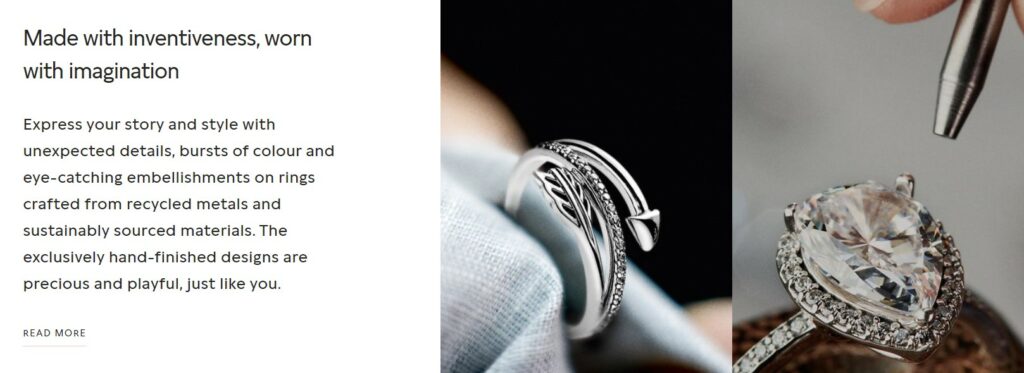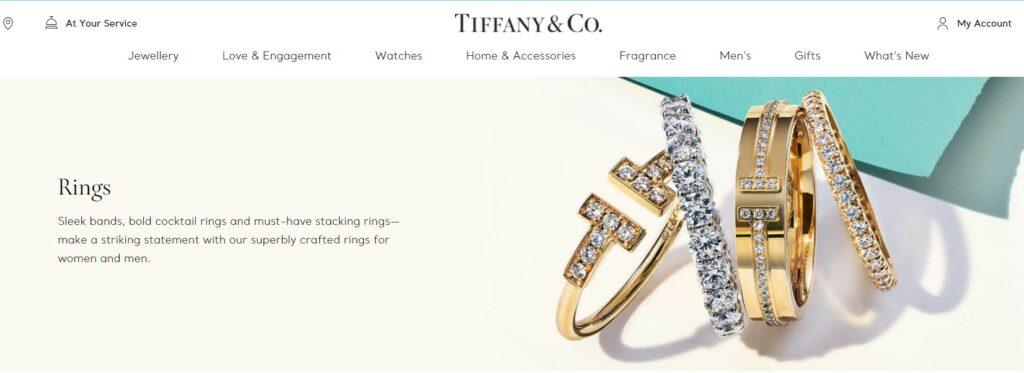Jewellery SEO Case Study: Analysis of Pandora & Tiffany’s Digital Marketing Strategy

It is only recently that a large proportion of luxury brands have begun investing in SEO strategies, having instead previously relied on brand awareness to drive sales. With the digital industry growing and becoming a busier platform they have begun to recognise SEO as a legitimate revenue source. Some jewellery brands, in particular, have bought into SEO and now have solid, successful strategies which have led to them dominating the search results.
The Importance of SEO for Jewellery Brands
It’s always been challenging to acquire new customers. This challenge remains true in today’s crowded marketplace, with expectations around online shopping experiences expected to match those consumers can receive offline.
Even some of the most established jewellery brands in the world can only see success if they launch their latest collections in a coordinated fashion that incorporates digital and SEO best practices.
Here are just some of the benefits SEO and digital marketing offer:
Market to Your Target Audience Effectively
Marketing to your target audience is a critical factor for any business, and thanks to the emergence of digital advertising, it’s now more straightforward. Of course, that’s not to say it’s easy, but before online advertising became popular, it was a case of developing an ad for all, hoping it would draw out your target audience through a crowd of noise and interruption.
Now, you can create target ads and content specifically for the consumers you want to reach.
Increase Website Traffic
In an industry where looks are everything, the digital world is perfect for jewellery brands to showcase their products. However, for potential customers to recognise the aesthetic beauty of your website, they need to get there!
This is where using digital marketing techniques to reach your target market and drive targeted traffic to your website is ideal.
Build Brand Awareness
The more extensive your online presence, the more recognisable your brand name will be. This is also true for jewellery brands looking for their brand to be at the forefront of consumers’ minds.
When developing a digital marketing campaign, whether SEO or a content marketing strategy, focus on creating clear and concise messaging that works together to market your brand online creatively.
Digital marketing within the jewellery industry is also a great way to enhance your brand’s image. Not only does it show customers your latest collections, but it can also create a positive online presence for all to admire, whether they are ready to become customers today or in the future.
Create a Global Offering
One of the most significant benefits of SEO and digital marketing is enhancing a company’s online presence and global website rankings. This can be priceless for a brand wanting to expand into a new market or looking to test campaigns in new territories before committing to a more expansive rollout.
What We Can Learn From Two of the Biggest Brands in the Jewellery Industry
SEO strategies are typically complex in nature, but here we analyse the structure of a website and how it grounds great technical SEO and content SEO strategies. First, we will concentrate on technical SEO, and keyword mapping to the correct pages, before moving on to analysing the content delivered on the sites. The examples are two very successful brands, Pandora and Tiffany’s. The structure of the site feeds the entire content strategy and affects how easily the site will be updated. The data shown from these two brands comes from Google UK.
TECHNICAL SEO STRATEGIES
Pandora
The first brand we will analyse is jewellery designer Pandora. Not the top end of the jewellery market Pandora sets itself apart from competitors by positioning themselves as affordable luxury. Their brand is known worldwide and this is reflected in their branded search positions.
| Keyword | Rank | Ranking Page |
| pandora | 1 | /en-gb |
| pandora uk | 1 | /en-gb |
| pandora rings | 1 | /rings/ |
| pandora bracelet | 1 | /en-gb/products/bracelets |
| pandora charms | 1 | /en-gb/products/charms |
| pandora necklace | 1 | /en-gb/products/necklaces-and-pendants |
The Pandora brand is now so strong that they have little to worry about in terms of branded searches. However, their current non-branded digital strategy is dominating the jewellery industry.
Pandora achieves this through a wide range of different, uniquely named URLs so that customers can be led straight to the specific page they are searching for. This means that the customers click on the most useful page possible, providing them with the best possible user experience.
| Keyword | Rank | Ranking Page |
| promise rings | 1 | /rings/promise-rings/ |
| earrings | 1 | /en-gb/products/earrings |
| bracelets | 1 | /en-gb/products/bracelets |
| earring | 1 | /en-gb/products/earrings |
| charms bracelet | 1 | /en-gb/products/bracelets |
| pendant necklace | 1 | /en-gb/products/necklaces-and-pendants |
| charms | 1 | /en-gb/products/charms |
| studs | 1 | /earrings/studs/ |
| disney charms | 1 | /en-gb/collections/disneycollection |
| bracelet charms | 1 | /en-gb/products/bracelets |
| necklace chain | 1 | /necklaces/necklace-chains/ |
| pamdora | 1 | /en-gb |
| jewelry rings | 1 | /en-us/rings/ |
| stack ring | 1 | /en-gb/products/rings |
| stacked ring | 1 | /en-us/rings/stackable/ |
| stacking rings | 1 | /rings/stacking-rings/ |
| stacked rings | 1 | /en-us/rings/stackable/ |
| studded earrings | 1 | /en-gb/products/earrings/290559cz |
| birthstone rings | 1 | /rings/birthstone-rings/ |
Pandora’s keywords have been carefully interwoven into their content strategy. Each URL contains a relevant dedicated keyword, including both specific keywords which are easier to target, to more generalised keywords which take much longer to rank for and have much stronger competition.
For example, they have a specific page dedicated to “necklace chains”, and the URL states “necklace-chains” so there is no room for confusion for either customers or Google. Search engines know exactly which page should serve users the best. “Stacked rings” is another example of how they use key terms in the URL “/rings/stacking-rings/”. This increases the range of keywords they can rank for, thus appearing for the broader range of terms such as “necklaces” and “rings”.
Tiffany’s
Our other example is the well-known jewellery brand Tiffany’s. A high-end luxury brand, they communicate their brand value but highlighting the history of the brand.
| Keyword | Rank | Ranking Page |
| tiffany | 1 | / |
| tiffany and co | 1 | / |
| tiffanys | 1 | / |
| tiffany engagement rings | 1 | /engagement/rings |
| tiffany engagement ring | 1 | /engagement |
| tiffanys engagement ring | 1 | /engagement |
| tiffany uk | 1 | / |
| tiffanys necklaces | 1 | /jewelry/necklaces-pendants |
| tiffany necklaces | 1 | /jewelry/necklaces-pendants |
| tiffanys necklace | 1 | /jewelry/necklaces-pendants |
| tiffany necklace | 1 | /jewelry/necklaces-pendants |
Similar to Pandora, Tiffany’s appear strongly for branded keywords. They focus on necklace and engagement keywords, directly associated with their brand to drive traffic to their site. However, their URLs are not as tightly structured as Pandora.
The table above shows a range of URLs which, though not quite as exact as Pandora, do reflect the brand categories. They reserve pearl jewellery for its own page, and dedicate diamonds to the engagement page, working from their brand’s persona, which famously associates Tiffany’s with engagement rings.
| Keyword | Rank | Ranking Page |
| yellow diamonds | 1 | /collections/tiffany-yellow-diamonds |
| women jewelry | 1 | /jewelry |
| shop jewelry | 1 | /jewelry |
| real pearl necklace | 1 | /jewelry/pearl-jewelry |
| jewelry for women | 1 | /jewelry |
| tiffanys and co uk | 1 | / |
| real pearl necklaces | 1 | /jewelry/pearl-jewelry |
| big diamond rings | 1 | /engagement |
| real pearls necklace | 1 | /jewelry/pearl-jewelry |
| jewellery collection | 1 | /collections |
From an SEO perspective, this means that Google will read these categories, and give the site more credit for terms such as jewellery and engagement, particularly as the content reflects this, which you will soon see.
CONTENT STRATEGIES
The content from these luxury brands reflects a strong structure with each brand presenting a strong online presence through their blogs.
In terms of SEO, every time they publish a blog post results into one more indexed page on their website, which means another opportunity for their brand to show up in search engines and drive traffic to their website in organic search.
Pandora
Pandora’s blog ‘Universe’ is the most active blog we’ve come across from a luxury jewellery designer, publishing multiple blog posts every week.
1. Landing Pages

Pandora’s landing pages contain a strong amount of copy, especially for an image-based site. They not only have category copy situated at the top of the page but also have an expanded version at the bottom of the page. While this is slightly unnatural for a page structure, the extra copy is obviously working well, as they are ranking on the first page for a wide number of keywords. The design of the bottom of the page means that the copy doesn’t look too out of place. We assume that this technique will be used in the fashion and jewellery industries, as brands try to get more copy on their pages without damaging the user experience.

2. Blog
The “Universe” has six main categories:
- Newest stories (all blog posts)
- Sneak peek
- Styling
- Craftmanship
- Seasonal trends
- On Our Wishlist
There is also the option of adding more filters to your search in the blog archive to find all the posts about the specific topic the reader is looking for. This ensures the reader can access the content they need quickly and don’t need to click on pages of blog posts to find information.
Pandora’s URLs are very simple and clear, but they also have some categories which cleverly highlight their products. For example, the ‘Sneak peek’ category gives a first look at the next collection launch. With colour schemes and styles identified, the reader is teased until the full collection is revealed. They can also add the new jewellery to their Pandora wish list before the collection is even released, solidifying potential purchases.
Users will also link to the new collection, which will help the site gain more links and keep their rankings strong.
The final category on the Universe blog is called ‘On our Wishlist’ and includes posts mainly focusing on products the blog writers are wishing for at the moment, which perhaps the readers also wants. It also jumps on current events such as Valentine’s Day and Mother’s Day to show gift ideas from Pandora. This allows Pandora to rank for key calendar events, and grab those gift searches. This will also pick up a range of links during those seasons which will contribute to a lift in rankings.
This simple URL structure clearly tells Google what URLs should rank for each keyword, and splits the blog into easy categories.
Tiffany’s
Tiffany was actually one of the first luxury brands who took online marketing and online sales seriously, and this has paid off as they are still one of the leading jewellery brands doing sales online.
1 . Landing Pages
Rather than adding copy to the category product page itself, as Pandora does, Tiffany’s has split the categories into subheadings and included guides and information about their products on separate pages. Tiffany’s also manages to include the word “gifts” in many of their subheadings, something which will help them target “gift” search terms.

While this isn’t a perfect strategy, it means that the site includes more keywords, ranks more pages, and adds context to search engines. It is also a good alternative for those brands who don’t want to add copy to their main landing pages, something many luxury brands are not ready to do.
2. Blog
Tiffany’s blog is named ‘The world of Tiffany’ and gives the reader an opportunity to explore the brand heritage, product styling suggestions, romantic inspiration and the latest news from Tiffany.
Tiffany’s blog differs from Pandora’s first and foremost in terms of layout. Where Pandora’s blog has a traditional blog layout with blog posts stacked underneath each other sorted by date with the latest blog post featuring at the top, the Tiffany blog is more fluid. It does not mean it is any less easy to navigate through. The blog has three main categories:
- The latest
- The Tiffany story
- The future is beautiful
While these are not the most searched for keywords, Tiffany’s has made up for it by their content.
For example, the second category, ‘The Tiffany story’, gives the reader insights into the story behind the Tiffany brand. In this category the reader can explore four further categories:
- Legacy
- Design
- Diamonds
- Timeline
All the content in the category is evergreen and does not have a date it’s published. It contains information that will always be relevant and does not need any further updates unless the there is a redesign of the site.
The final blog category is called ‘The future is beautiful’. The blog content in this category gives the reader insights into Tiffany’s commitment to maintaining the highest standards of social and environmental responsibility.
However, despite the title, the URL strategically uses the word sustainability, which is probably what the reader was searching for in their preferred search engine. While Pandora clearly creates and structure their URLs, Tiffany’s affords a little creativity by balancing brand tone, keywords and content expertly.
CONCLUSION
When creating content for a site it is important to choose a URL structure that is both flexible and easily understood by Google. If you need to be creative ensure you base your content around a particular keyword, as Tiffany’s does.
Analysing these two major jewellery brands which both have successful blogs, it is easy to see how you can build and run a blog for similar brands. Pandora’s blog is always on brand and focuses on the latest products. However, Tiffany focuses not only on their products but more on their brand heritage, as well as their social and environmental responsibility.
Both blogs work well for the purpose of building a brand persona, giving the consumers better access to information and increasing the number of indexed pages on their website, which makes them more dynamic and a higher rank in Google. But the reason they work so well is due to their simple, yet effective URL structure.
If you need help from a luxury SEO agency based in London please get in touch.
If you found this post helpful, why not stay up to date and follow us on Instagram or Twitter, and make sure to keep an eye on our blog for our next case studies on influencer marketing and outreach.









